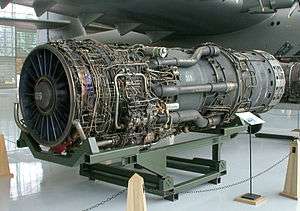JP-7

JP-7 (Jet Propellant 7, MIL-DTL-38219[1]) is a jet fuel developed by the U.S. Air Force for use in supersonic aircraft because of its high flash point and thermal stability. It is the fuel used in the Pratt & Whitney J58 engines, used in the Lockheed SR-71 Blackbird. The skin friction of the aircraft's surface with the atmosphere at Mach 3+ cruising flight generates very high skin temperatures; therefore this special fuel was needed. The story told by Ben Rich in his book Skunk Works is that a lit match can be dropped in a bucket of JP-7 and the fuel will not ignite, and the match will be extinguished.
The Boeing X-51 Waverider uses JP-7 fuel to run the Pratt & Whitney SJY61 scramjet engine, with fuel capacity of some 270 lb (120 kg).[2] As with the SR-71, the X-51A design super-cools this fuel (cooled by extended subsonic flight in the stratosphere; prior to acceleration to supersonic speeds); then, when in supersonic flight, the fuel is heated by its circulation through heat exchangers which transfer to it the heat load of the interior spaces of the airframe. The fuel is then pumped through rotating mechanical parts of the engines and auxiliary mechanical equipment, providing both lubrication and cooling. Finally at a temperature of nearly 550 degrees, it is pumped into the fuel nozzles of the engines.[3]
JP-7 is a mixture composed primarily of hydrocarbons, including alkanes, cycloalkanes, alkylbenzenes, indanes/tetralins, and naphthalenes, with addition of fluorocarbons to increase its lubricant properties, an oxidizing agent to make it burn better, and a cesium containing compound known as A-50, which aided in disguising the radar and infrared signatures of the exhaust plume. The Blackbirds used approximately 36,000–44,000 pounds (16,000–20,000 kg) of fuel per hour of flight.
JP-7 is unusual in that it is not a distillate fuel but is created from special blending stocks in order to have very low (<3%) concentration of highly volatile components like benzene or toluene, and almost no sulfur, oxygen, and nitrogen impurities. It has low vapor pressure and high thermal oxidation stability. It must operate across a wide range of temperatures, from near freezing at high altitude, to high temperature of airframe and engine parts being cooled. Its volatility must be low to make it flash-resistant in these high temperatures.
The very low volatility and relative unwillingness of JP-7 to be ignited required triethylborane (TEB) to be injected into the engine in order to initiate combustion and allow afterburner operation in flight. The SR-71 had a limited number of "shots" of TEB (usually 16) and those had to be managed carefully on long-duration flights with multiple stages of relatively low-altitude air refueling and normal high-altitude cruise flight.
History
The operating envelope of the JT11D-20 engine requires special fuel. The fuel is not only the source of energy but is also used in the engine hydraulic system. During high Mach flight, the fuel is also a heat sink for the various aircraft and engine accessories which would otherwise overheat at the high temperatures encountered. This requires a fuel having high thermal stability so that it will not break down and deposit coke and varnishes in the fuel system passages. A high luminometer number[nb 1] (brightness of flame index) is required to minimize transfer of heat to the burner parts. Other items are also significant, such as the amount of sulfur impurities tolerated. Advanced fuels, JP-7 (PWA 535) and PWA 523E, were developed to meet the above requirements.
Shell Oil developed JP-7 in 1955. Company vice president Jimmy Doolittle arranged for Shell to develop the fuel for the Central Intelligence Agency and United States Air Force's secret Lockheed U-2 spy plane, which needed a low-volatility fuel that would not evaporate at high altitude. Manufacturing several hundred thousand gallons of the new fuel required the petroleum byproducts Shell normally used to make its Flit insecticide, causing a nationwide shortage of that product that year.[5]
Properties
- Melting Point −30 °C (−22 °F)
- Boiling Point (1 atm) 282–288 °C (540–550 °F)
- Density (at 15 °C) 779–806 kg/m³
- Vapor Pressure (at 300 °F (149 °C)) 155 mmHg (3.00 psi) (20.7 kPa)
- Flashpoint 60 °C (140 °F)
- Net heat of combustion min. 43.5 MJ/kg
See also
References
- Notes
- ↑ Note that a high luminometer number corresponds, somewhat counter-intuitively, to a low brightness for a given amount of heat generated.[6] Therefore a high luminometer number means that, for a given amount of energy released in combustion, more of the energy goes into heating the gas, and less into heating the surrounding structure through radiative transfer, than would be the case for a low luminometer number fuel. But this does not say anything about other mechanisms of transfer, e.g., diffusive transfer, which may be greater or lesser.
- References
- ↑ MIL-T-38219D Military Specification, Turbine Fuel, Low Volatility, JP-7
- ↑ "Factsheets: X-51A Waverider". U.S. Air Force. 2011-03-23. Archived from the original on 2016-04-18. Retrieved 2011-07-25.
- ↑ "X-51 Waverider makes Historic Hypersonic Flight". Scientific Computing. Retrieved 2011-07-25.
- ↑ SR-71A Flight Manual. sr-71.org. 31 July 1989. Retrieved 27 November 2013.
- ↑ Pedlow, Gregory W.; Welzenbach, Donald E. (1992). The Central Intelligence Agency and Overhead Reconnaissance: The U-2 and OXCART Programs, 1954-1974 (PDF). Washington DC: History Staff, Central Intelligence Agency. pp. 61–62.
- ↑ Bachman, K.C. (1961). "Relation of Luminometer Number to Molecular Structure and Smoke Point". Journal of Chemical Engineering Data. 6 (4): 631–634. doi:10.1021/je60011a045.
- Bibliography
- Rich, Ben R. and Leo Janos. Skunk Works: A Personal Memoir of My Years at Lockheed. New York: Little, Brown and Company, 1994. ISBN 0-316-74330-5.
- Faroon, Obaid; Mandell, Diane; Navarro, Hernan. Toxicological Profile for Jet Fuels JP-4 and JP-7. Agency for Toxic Substances and Disease Registry, Atlanta, June 1995.